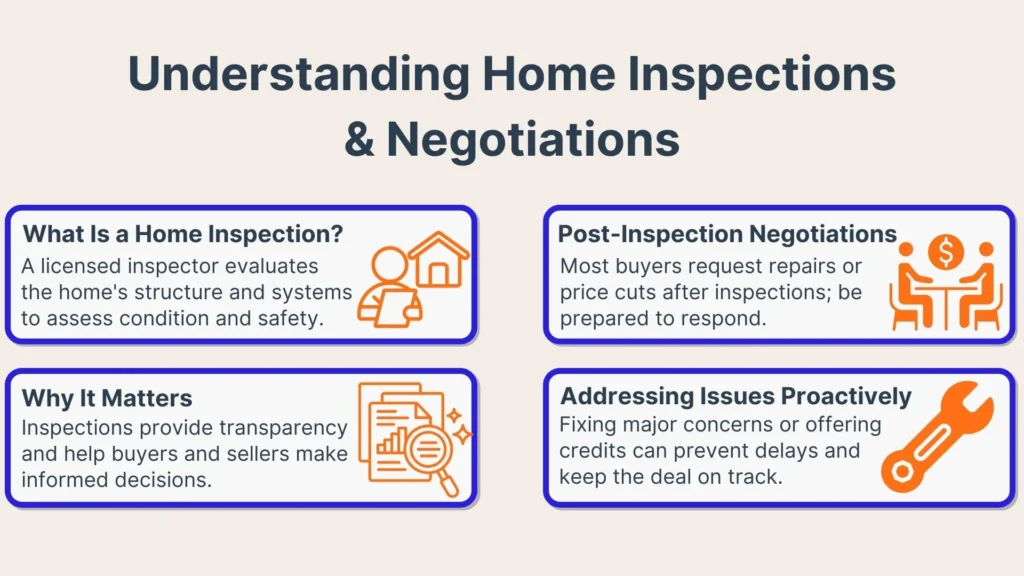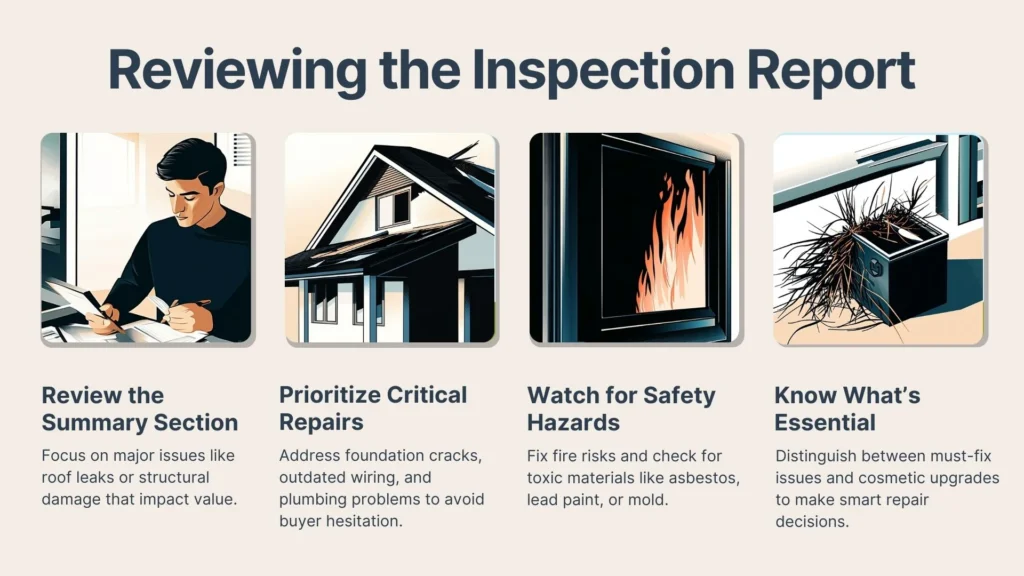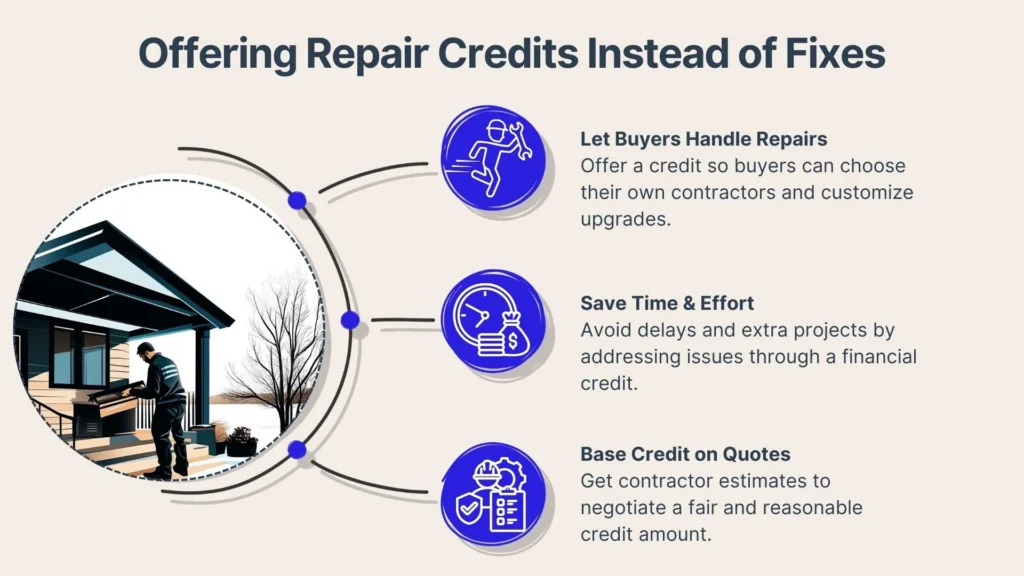Are you selling your home independently and facing the tricky waters of post-inspection negotiations? You're not alone. 86% of home inspections uncover issues that buyers often use to negotiate a lower price, typically reducing the final sale price by an average of $14,000.
But don’t worry, there are effective strategies to keep the buyer interested and close the deal smoothly. Whether the issues are minor repairs or major structural concerns, being informed about your options puts you in the driver’s seat. Continue reading to learn how you can navigate post-inspection negotiations with confidence and keep both you and the buyer on track for a successful sale.
Understanding Home Inspections
A home inspection is a detailed evaluation of a property’s condition performed by a licensed professional. This process helps buyers understand the home’s structural integrity, safety, and major systems before finalizing a purchase. An inspector typically examines the foundation, roof, plumbing, electrical system, HVAC, and more.
Certified home inspectors conduct inspections based on established guidelines. While regulations vary by state, inspectors follow standards set by organizations like the American Society of Home Inspectors (ASHI) or the National Association of Home Inspectors (NAHI). Their objective assessment provides transparency, helping both buyers and sellers make informed decisions.

Why Negotiating Post-Inspection Is Crucial
Negotiating after a home inspection is key to the success of the home-selling process. Once an inspection reveals any issues, buyers often want to revisit the terms to account for the costs of necessary repairs or updates.
According to the National Association of Realtors (NAR), 86% of buyers request repairs or price reductions after receiving their home inspection report. Understanding the importance of post-inspection negotiations can help FSBO (For Sale By Owner) sellers retain buyer interest and close deals efficiently.
How Inspection Results Influence Negotiations
Inspection results significantly impact negotiations and buyer confidence. When major issues like structural damage, roof problems, or outdated electrical systems are revealed, buyers might rethink their offer or consider withdrawing from the deal altogether.
Proactively addressing these concerns can prevent delays and reassure buyers of the home's value. In certain situations, the inspection findings might warrant a price adjustment or seller credits, which can help keep the transaction moving forward.
Preparing for the Home Inspection
Being upfront about your home’s condition builds trust and can help prevent post-inspection renegotiation. Providing maintenance records also helps demonstrate that the home has been well cared for, reducing the likelihood of surprise findings derailing the deal.
Here are key steps to get your home inspection-ready:
- Address Minor Repairs: Fix leaky faucets, replace burned-out light bulbs, secure loose handrails, and ensure all doors and windows open and close properly. Small issues can raise unnecessary concerns.
- Service Major Systems: Have your HVAC system professionally serviced, replace air filters, check for plumbing leaks, and inspect your electrical panel for any obvious issues.
- Declutter and Clean Thoroughly: A tidy home not only makes a good impression but also allows the inspector easy access to areas like attics, basements, and utility rooms.
- Check Exterior Condition: Inspect the roof for missing shingles, clear gutters, and ensure proper drainage around the foundation to prevent water-related concerns.
- Test Safety Features: Verify that smoke detectors, carbon monoxide detectors, and GFCI outlets are functioning properly. These are common items on an inspection report and are easy to address in advance.
- Provide Documentation: Gather warranties, receipts for repairs or maintenance, and records of any upgrades.
Reviewing the Inspection Report
After thoroughly reviewing the inspection report, it's important to digest the information and understand what it means for your home sale. This summary of the house's condition will guide your next steps, making sure you're well-prepared to address any concerns and move forward confidently with potential buyers:

Summary of the House’s Condition
The summary section of the inspection report gives you a handy snapshot of your home’s overall condition. It commonly highlights pressing concerns like roof leaks, structural issues, outdated wiring, plumbing problems, or even signs of mold or pest damage. By zeroing in on these items, you’ll know right away which repairs are most critical for maintaining your home’s value and for keeping buyers confident in their purchase.
Detailed Repairs List
Inspectors document specific issues found during the inspection, which typically include structural concerns and electrical and plumbing deficiencies. Structural issues such as foundation cracks and roof damage can significantly impact a home’s value and longevity. Addressing these problems early can prevent negotiations from stalling and reassure buyers of the home’s stability.
Electrical and plumbing fixes are another common category in inspection reports. Outdated wiring, overloaded circuits, and leaking pipes can raise concerns about safety and long-term maintenance costs. Additionally, inspectors look for fire hazards like faulty wiring or missing smoke detectors, as well as toxic substances such as asbestos in insulation and lead-based paint or mold growth.
Identified Safety Hazards
Fire hazards are a major concern in any home inspection. Faulty wiring, missing or non-functional smoke detectors, and issues related to fireplaces or chimneys can all present significant risks. Inspectors assess whether electrical systems meet safety codes and whether fire prevention measures, such as smoke and carbon monoxide detectors, are properly installed and operational.
Another critical area of concern involves the presence of toxic substances. Older homes may contain asbestos in insulation or ceiling tiles, and lead-based paint is still found in many pre-1978 homes. Mold growth, often caused by leaks or poor ventilation, is another major issue that can affect indoor air quality and pose health risks.

Interpreting Required Vs. Optional Fixes
Not all inspection findings require immediate action. Understanding the difference between necessary and cosmetic fixes prevents unnecessary concessions. Repairs like a leaky roof or outdated electrical systems need immediate attention because they affect the home's safety and functionality. These are non-negotiable if you want to keep your home's value intact.
Cosmetic fixes, such as a fresh coat of paint or new carpets, are optional. They can make your home more appealing but aren’t essential for closing the deal.
Assessing the Findings
With the inspection report in hand, focus on sorting out the real problems from the optional ones. A few repairs may need attention to keep your sale running smoothly, but not every item on the list demands urgent care:
Necessary Vs. Optional Repairs
When reviewing inspection findings, it helps to separate must-do repairs from those that are simply nice to have. Issues such as leaking roofs, foundation concerns, or outdated electrical systems may heavily influence the buyer's confidence and could even affect their financing options.
On the other hand, optional improvements, like applying fresh paint or updating light fixtures, can enhance the home's appeal without being required. While these updates can impress buyers, they rarely jeopardize the sale if left undone.
Estimating Repair Costs
Getting accurate repair estimates ensures fair negotiations. Seek quotes from local contractors or use online tools to determine ballpark figures.
Negotiation Strategies
Now that you have considered different strategies for discussing inspection findings, it might be time to look at an option that balances buyer needs with your available budget:
Offering Partial Repairs
If major issues arise, offering to fix only the most pressing ones can be a good compromise. This approach works well for costly repairs where the buyer may prefer handling them after closing.
Prioritizing Safety-Related Fixes
Prioritizing safety-related fixes helps prevent deal-breakers and reassures buyers. Addressing outdated wiring, gas leaks, or structural issues reduces risks and avoids costly negotiations. Upgrading old electrical systems, repairing leaks, and securing loose railings improve safety and buyer confidence. Simple fixes like replacing smoke detectors and leveling uneven flooring also make a home feel move-in ready.
Providing a Repair Credit

Providing a repair credit instead of making repairs yourself can be a good way to address inspection items without taking on extra projects. For instance, if the inspection shows a leaky faucet or suggests updating an older heating system, you can offer credit so the buyer can hire a contractor and handle those fixes after closing.
This approach can be especially helpful when buyers have ideas about how they want to upgrade or repair the home, such as choosing specific flooring types or redesigning certain areas.
To figure out a fair credit amount, gather quotes from reputable contractors for any major work highlighted in the inspection. For example, if contractors estimate around $2,000 for roof repairs, you might negotiate a credit close to that range.
Adjusting the Sale Price
If the inspection reveals significant problems, adjusting the sale price can be an effective alternative to offering repair credits. This strategy appeals to buyers who prefer handling repairs themselves.
Evaluating Buyer Demands
Some buyer requests for repairs are reasonable, especially when they involve habitability or safety concerns. Addressing these key issues can reassure buyers and help keep the sale on track. However, not all demands warrant action, and sellers should weigh each request carefully.
If a buyer asks for upgrades beyond the initial agreement, politely declining is an option. Similarly, if repair costs significantly cut into your profit or make the sale impractical, reassessing whether to move forward may be necessary.
Finalizing the Agreement
To avoid misunderstandings, it’s important to document all negotiated repairs or credits in writing. Any changes to the original sale terms should be formally recorded in a contract addendum or amendment. Consulting with a real estate attorney can help confirm that all adjustments are legally binding and properly documented.
Once the agreement is in place, the next step is confirming that all negotiated repairs or credits are completed before closing. A smooth transition to closing depends on fulfilling these obligations, confirming that everyone is satisfied, and preparing for a seamless handover of the property.
Conclusion
Clarity and honesty help make post-inspection talks run smoothly. Addressing significant safety issues keeps buyers from walking away and demonstrates your commitment to a successful sale. You can also opt to provide repair credits or reduce the price instead of handling every fix yourself, allowing both parties to decide what works best.
If you're selling FSBO, handling post-inspection negotiations effectively can make a significant difference. Whether you decide to fix issues or adjust the price, staying informed and prepared helps you close the deal smoothly. Looking for an easy way to manage FSBO transactions? Consider using Propbox, a streamlined platform designed to help sellers navigate negotiations and closing with confidence.
